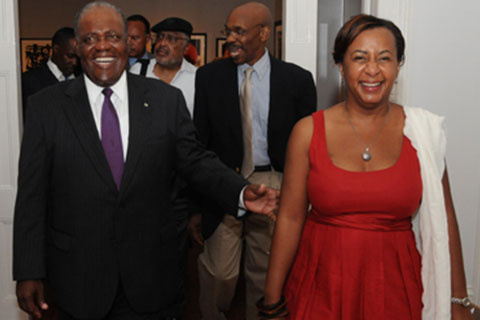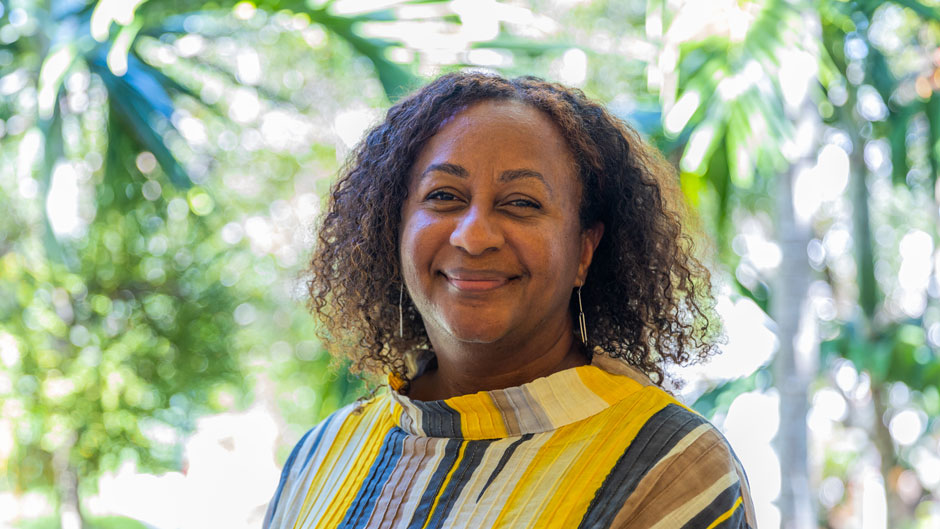Lately, art history assistant professor Erica Moiah James has been struggling to keep away from Facebook. The images of her native Bahamas, where she was the founding director of the national art gallery, are both distressing and consuming her.
James feels fortunate. Her parents, extended family and most friends — along with the gallery — are safe in Nassau, about 100 miles from the worst destruction of Hurricane Dorian. But as she fielded calls from concerned friends and colleagues throughout the Caribbean, the storm forced James to realize the grim impacts of climate change on the region. It even prompted her to write a piece for The New York Times on the need for governments to work together in what is sometimes a fractured region.
“Every year it’s someone,” she said. “This is the new normal.”
James, who teaches African Diasporic Art Histories with a focus on the Caribbean at the University of Miami College of Arts and Sciences, made many of her connections across the Caribbean as the founding curator and director of the National Art Gallery of The Bahamas (NAGB).
Her journey to that position, where she gave tours to everyone from the prime ministers of the country, to Ms. Universe contestants, the First Lady of South Africa and the Secretary General of the United Nations, was heralded by a series of strong mentors, James said.
Growing up in Nassau, an art museum on the island was just a fantasy for James. Although she always loved to draw and paint, James’ desire to be an artist seemed a bit farfetched to her parents, so she compromised – and decided to major in architecture and urban studies at Vassar College. Yet when it was time to craft her thesis, James drafted a gallery design, and wrote a paper about the need for a space to showcase fine art from The Bahamas and the wider Caribbean.
“And then I sort of put that dream away and graduated and went to art school,” she said.
Many years later, after honing her painting skills and earning a Master’s of Fine Art at the University of Chicago, as well as working as a collections manager at the DuSable Museum of African American History, James was three years into her Ph.D. in art history at Duke University, when she got a call from Nassau. It was the board of directors looking to start a national art museum, and they asked if she would be interested in working there. James immediately sent them her resume. She did not hear anything for a year. When she finally went to interview, they asked her what day she could start.
“The artists kept pushing for it, and eventually my training met the national will,” she said. “It was kismet.”
James started working at the gallery in 2003, six months before it opened. Located at the former home of the first chief justice of The Bahamas, Williams Henry Doyle, she was initially named as the gallery’s visiting curator. James worked feverishly to renovate the space and furnish it, as well as to hire staff.
“It still wasn’t set up as a museum, so all of my architecture training came in really handy then,” she said.
When the museum opened, James was promoted to director and chief curator, a post she held for eight years. James said it was extremely difficult to leave, but she is proud of the museum’s growth and its impact. As a result, The Bahamas is incorporating more art programs in schools and native Bahamians have a place to see the evolution of art in their own country, James said.

“It wasn’t a part of our culture we had developed before, but by the time I left, people gave me a chance to see that the work we did mattered, and I saw how it had grown to reach out and impact the community,” she said. “Not many people get that opportunity; I understood the work that an institution like the NAGB needed to do for The Bahamas.”
James was enticed to take a break from the museum when she was offered a temporary post-doctoral teaching fellowship at Washington University in St. Louis. She had recently finished her Ph.D. at Duke and was interested in returning to an academic setting.
“Life changed very quickly after that,” she said.
Shortly after she began her fellowship, James was offered a position as a professor of Caribbean and African Diasporic art histories at Yale University. After some hesitation — she had planned to return to The Bahamas — James decided to teach art history, along with African American history at Yale and left her museum position. At Yale, James began teaching full-time, wrote a book about the art of Bahamian collector Dawn Davies, and curated exhibits across the country. Then two years ago, she was approached by University of Miami to interview for an opening in the art history department. She decided that she wanted to be closer to home.
Nathan Timpano, who serves as the area head for art history in the Department of Art and Art History, said James “is a perfect example of UM seeking out desirable professors,” and that she is the only professor in their department who teaches art of the Caribbean, or African art.
“She is really filling a gap that had previously existed in our curriculum,” he said, adding that students often comment about how much they enjoy her classes. “Also, the fact that she is both a highly trained art historian and a skilled painter provides a dual perspective on the discipline that’s really unique.”
Rosie Gordon-Wallace, the founder of Diaspora Vibe Cultural Arts Incubator (DVCAI), an organization that works to cultivate and elevate Latin American and Caribbean artists’ work in the United States, said James’ insight about Caribbean art is invaluable. When she opened the National Art Gallery of The Bahamas in Nassau, Gordon-Wallace said James helped create a cultural springboard for Bahamian artists like Blue Curry, John Beadle, Heino Schmid and John Cox, who are internationally recognized today.
“Erica has been at the helm of the maturation of contemporary Caribbean art in The Bahamas,” said Gordon-Wallace. “She is also rigorous in her knowledge of the Caribbean, and in placing that knowledge in the canon, as well as in the contemporary canon in America.”
Gordon-Wallace said James is writing an essay for an upcoming DVCAI exhibit that opens Nov. 16 at the Corcoran School of Art and Design in Washington, D.C. James is also opening a different contemporary Caribbean art exhibit at Miami’s Little Haiti Cultural Complex in December. In between, she is teaching classes on Cuban Art, African Art and Western Art, and hoping to get back to The Bahamas, so she can help the survivors of Hurricane Dorian in any way possible.
Although James is grateful her family was spared from Dorian, she is still concerned about the future of her country. She hopes the University of Miami continues its intensive research on climate change issues to find solutions to pressing problems such as medical health impacts and resilient building methods, among others.
“I hope UM can be a nexus for the necessary conversations we need to have about, and actions we must take, on climate change," she said. “We are all facing the same battle.”

